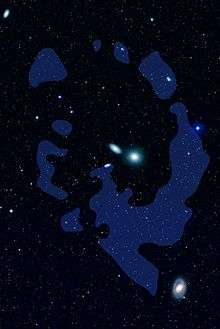Leo Ring
The Leo Ring is an immense intergalactic cloud of hydrogen and helium gas some 650 kilolight-years (200 kpc) in diameter, in orbit of two galaxies, in the center of the Leo Group of galaxies, within the constellation of Leo.
| Interstellar cloud | |
|---|---|
| Intergalactic cloud | |
| H I region | |
 | |
| Observation data: J2000.0[1][2] epoch | |
| Right ascension | 10h 48m 19.0s [2] |
| Declination | +12° 41′ 21″ [2] |
| Distance | 38±4.6×106 [2] ly (11.8±1.4×106 [2] pc) |
| Constellation | Leo |
| Physical characteristics | |
| Radius | 325×103 [3] ly (100×103 [4] pc) |
Observation history
Radio astronomers discovered the cloud in 1983. Astronomers had theorized that the ring was primordial gas in the process of forming a galaxy. The GALEX satellite detected ultraviolet emissions that astronomers at Johns Hopkins University and the Carnegie Institution for Science interpret to indicate star creation in newly forming dwarf galaxies in a 19 February 2009 Nature paper.[5] In 2010, it was found that the gas was not primordial, but the result of a galactic collision between the two galaxies with which the ring is closely associated.[3]
Formation history
A billion years ago, NGC 3384 collided with M96, at the heart of the Leo Group, expelling a galaxy's worth of gas into intergalactic space. This gas gathered into a vast set of clouds, the Leo Ring.[3][4]
The two galaxies have now drifted to being 38 Mly (12 Mpc) apart, and the ring is now 650 kilolight-years (200 kpc) wide. The ring is composed of a collection of H I regions. A bridge of gas connects the ring to M96.[3][4]
References
- "NAME Leo Ring". SIMBAD. Centre de données astronomiques de Strasbourg.
- "Leo Ring". NASA/IPAC Intergalactic Database.
- Léo Michel-Dansa; Pierre-Alain Duc (2010). "The mysterious Leo giant gas ring explained by a billion year old collision between two galaxies". Canada France Hawaii Telescope.
- Michel-Dansac, Leo; Duc, Pierre-Alain; Bournaud, Frederic; Cuillandre, Jean-Charles; Emsellem, Eric; Oosterloo, Tom; Morganti, Raffaella; Serra, Paolo; Ibata, Rodrigo (2010). "A collisional origin for the Leo ring". The Astrophysical Journal Letters (published July 2010). 717 (2): L143–L148. arXiv:1005.4208. Bibcode:2010ApJ...717L.143M. doi:10.1088/2041-8205/717/2/L143.
- "New stars from old gas surprise astronomers". PhysOrg.com. 18 February 2009. Retrieved 18 February 2009.